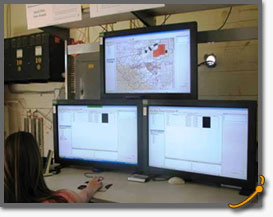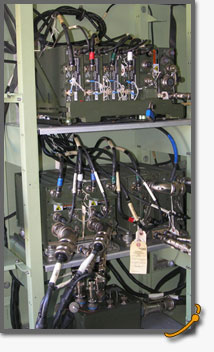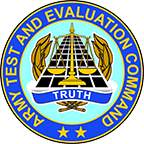- Homepage >
- Facilities >
- Communication Systems & Networks (CS&N)
Communication Systems & Networks (CS&N)
Mission
The Communication Systems and Networks (CS&N) mission is to provide quality, efficient, timely, value-added test services including comprehensive Command, Control, Communications, Computers and Intelligence (C4I) systems, System of Systems (SoS) and network performance information. The CS&N takes pride in providing acute, detailed information and documented test results to assist with the production of the best possible product to the Warfighter.
Overview

The CS&N provides a relevant environment to assess legacy, current force and future technologies. The CS&N plans, conducts, analyzes and provides a venue for technical tests of systems. This includes C4I systems and SoS. The CS&N has expertise in testing a wide variety of radios and networks for many military program managers (PM) such as WIN-T, GMR, HMS, SINCGARS, and JCR/FBCB2.
Current Capabilities
Fabrication
- Technical expertise and resources are available at the CS&N to design and fabricate specialized cables, test fixtures, mechanical prototypes, and electronic test aids.
Testing
- Desensitization: Provides information on degradation of radio systems’ receiving sensitivity as a result of integration into an environment that may be producing electromagnetic interference.
- Co-site: Provides information on co-location of radio communication systems on the same platform that cause an effect of unwanted energy due to one or a combination of emissions, reflection, or inductions up a receiving radio communications system, which decrease range or the distance of radio communications.
- Antenna isolation: Provides results on the amount of Radio Frequency (RF) energy being injected from one co-located antenna to another on the same ground plane, which takes into account the physical 3-dimensional spacing/relationship, nearby objects, and the varying frequency response of the antennas.
- Communications Range: Utilizes the open air line of site areas of Fort Huachuca, and the surrounding area to provide information on a radio’s performance at maximum distances.
- Network/Communications Performance: A measure of a system’s computers and communications (C2) abilities end to end. It verifies that network parameters are correct and provide network characteristics. Examples of network parameters include network architecture and network configurations. Examples of network characterization are maximum throughput, latency, proper passage of priority messages and message completion rates.
- Distributed testing: Provide comprehensive robust test capability through connection to remote locations via Defense Research Engineering Network (DREN), TITAN, and Over-the-Air using satellite emulators with various frequency capabilities; UHF, C-Band, L-Band, KU-Band, KA-Band, and X-Band. Utilization of the instrumentation sheds using NSA approved alarm technology for testing equipment in a fielded environment without the need to have an on-site operator for security.
Facilities

- Tactical Radio Lab: PM established GMR training and GMR software/hardware validation facility.
- Static and Mobile TOCs: Provides a configurable suite of ABCS platforms that can be used to simulate Battalion, Brigade, and Division echelons. The TOCs platforms include: BCS, CPOF, MCS, AFATDS, AMDWS, BCS3, AIC, GCCS-A, C2PC, and FBCB2.
- TCC: Tests can be monitored and controlled at Fort Huachuca and throughout the country in the two control rooms with large overhead monitors to display information. Meetings, classes, and conferences can be conducted in the state-of-the-art multimedia training room. The multimedia room has monitors in the tables and several large screens to display information.
Future Capabilities
- Maturation of System of Systems (SoS) test and evaluation capabilities to support Future Objective Force C4ISR systems and Expand mobile capabilities.


